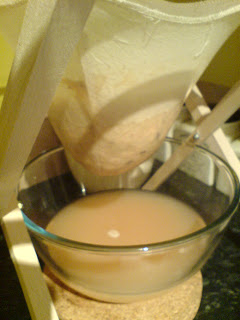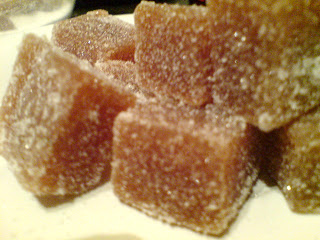Tag: quince
#275 Pears in Syrup
“Your old virginity is like one of our French withered pears: it looks ill, it eats dryly.” Bertram, As You Like It
This is an old, old recipe that Griggers herself has updated rather. In Medieval times a variety of pear called Wardens were used that were rock hard and required an hour’s cooking beforehand. These days, we use eating pears so it’s a lot quicker to make. It is best though to use unripe pears for this, though it doesn’t really matter what kind.
A some of you may know, one of my gripes is picky eaters. Vegetarianism and veganism don’t come under that term ofr me though. I think making a moral stance against eating animals or using the products of animals certainly has a lots of merit. Not eating honey is a bit stupid though. Anyway, what IS annoying is veggies who ARE picky. I mean, what is the point of restricting your diet if you don’t like most stuff anyway. Luckily noone fell into that category this night!
#114 Quince, Medlar, Sorb or Crab Apple Jelly
The quinces I bought the other day were beginning to look a bit sad and I needed to use them up with something. I really like quince, so quince jelly was the obvious choice – making a few jars of this would mean I would still be eating them way beyond their season had ended.
By the way, this recipe can be followed as is but with medlars, sorbs or crab apples, so if you are lucky enough to know where their might be some growing near you try this jelly.

Quince jelly can be used like any fruit jelly, but is typically an accompaniment to cheeses, game and turkey.

#114 Quince Jelly – 6.5/10. A nice conserve, but I perhaps more apple than I should have, as the quince flavour is not super strong and is sweeter than I’m used to. That said, I used as jam and I think it’ll be a lot better with some game or cheese. Also, the recipe’s very good as I got four jars of jelly from just two quince!
#109 Quince Comfits
I went into Unicorn in Chorlton, Manchester to stock up on my favourite seasonal fruit and vegetables – this time of year they are quince, Jerusalem artichokes and Seville oranges. Once I’d bought them, it was a quick trawl through the book to see what I could do with them. The one recipe that didn’t require me to buy anything extra, other than was in my store cupboard, was quince comfits; all they need is water and sugar.

FYI: A comfit is a sugary sweet, rather like a pastille, that go way back In fact, quince comfits were made as part as Henry IV’s coronation banquet in 1399. This is a fact that I’m still in awe of. Get some made if you find some quinces and have a rare medieval treat!
Scrub the fluffy stuff that coats the quince’s skins, wash them thoroughly, and chop roughly. Put them in a pan with around an inch of water and simmer them, covered, until they are very soft. This takes a while as they are so hard, so keep a check on them and add extra water if need be to prevent them boiling dry. Once they are very soft, pass them through a sieve and weigh the pulp. Return it to the pan and add an equal weight of sugar. Bring it to the boil and allow to simmer, pop and bubble for up to half an hour. Make sure you stir it often to prevent it catching. It is ready when the mixture comes away from the sides as you stir. Pour the mixture into Swiss roll tins or sandwich tins that have been lined with greaseproof paper. Now you have to be patient – the mixture has to be dried slowly in a very low oven (less than 50ºC) or in the airing cupboard for a few days. Cut it into squares and shake the sweets in a tub of caster sugar to coat them. Hey Presto: Medieval sweets!
Griggers reckons they’re really good melted on grilled pork chops.

#109 Quince Comfits – 7/10. I love quince. I think they’re my second favourite fruit after the raspberry. Their wonderfully perfumed toffee flavour really does come across in these little sweets. I don’t really go for sweets like this usually, but these are good and have the added interest of being eaten by a medieval king!
#20 – Quince Vodka (Part 2)
#20 Quince Vodka (Part I)
#17 Quince Cream
Luckily for the Grigson it tasted nice! It was creamy but light. I’m going to have to try and reduce the amount of cream and butter in my diet though! I can feel my arteries harden as I type!
#17 Quince Cream – 7.5/10. Anything with quince is OK by me! I’m starting to get sick of all these calories though!
#16 Palastine Soup
OK. Something with Jerusalem artichokes…
…(#16) Palestine soup. Brilliant. FYI Jerusalem artichokes have nothing to do with Jerusalem or artichokes. It was thought that they tasted similar to artichokes, but I don’t think they do. Jerusalem is a corruption of the word Girasole, which is the Italian for sunflower. (I used to grow them in the garden of my old house, and their flowers are like tiny sunflowers.) They are a much under used vegetable – at one point, before the domestication of the potato, it was attempted to make the Jerusalem artichoke a staple crop. It was considered too strong in flavour, and what a shame!
The soup was pretty easy; start by blanching a pound of Jerusalem artichokes in boiling salted water so that the knobbly skins can be peeled away. Place the peeled artichokes in the cooking water to prevent them discolouring. Meanwhile, gently cook 4 ounces of chopped onion, a crushed garlic clove and an ounce of chopped celery. When soft, add two rashers of streaky bacon and then after two minutes add the artichokes and 2 ½ pints of chicken stock. Simmer until the artichokes are tender then blitz. Finally stir in two ounces (!) of double cream and two tablespoons of chopped parsley. And then serve, under the strict Grigson rules, with croutons. It made a lovely soup – really brought out the earthy flavour of the Jerusalem artichokes. It’s the best Grigson soup so far. I made a veggie version for Greg too using veggie bacon (!) and vegetable stock. It tasted as good as mine.
Greg says:
Palestine soup – This is my fave recipe to date I think. I had the girl version which Neil made in a separate pan using veg stock instead of chicken stock and veggie bacon instead of real piggy which meant my soup went a litle bit pink due to the colouring and smelt more like bacon than the real stuff! It was clearly the better of the two though possibly not admissbale under the strict Grigson regime. Anyways, the smoky bacony flavour together with the cream and that very specific Jersualem artichoke flavour was honestly amazing, if I’d had it in a restauarnt I would have been supremely chuffed. The croutons were alright but I could live without em, the fresh parsley is garnish enough. Wonderful . 9/10.
#16 Palestine Soup – 8.5/10. A brilliant winter-warmer! It should be part of everyone’s repertoire!



